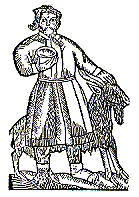Sudovian language
Sudovians, Yatvingans or Yatviags were a Baltic tribe which lived in the
1st millennium AD in what is now Belorussia and East Poland. They inhabited
vast forest regions between the Neman and the Narev rivers, but were too
weak and disorganized to take an attempt of creating their own state. In
the 10th century a lot of Yatvingans were united with Kiev Russia by the
army of Kiev Prince Vladimir. Three centuries later those Yatvingans who
managed to survive surrounded by strong Russians, Poles and Lithuanians
lost their lands completely to Lithuanian Great Principality.
Soon all of Yatvingans were assimilated by Lithuanians and forgot their
language with only dialectal differences left. Nowadays, though some revival
is noticed, as well as research and reconstruction work is carried out,
Sudovian is considered a dead, extinct language.
 It
was an archaic East Baltic tongue, similar to Old
Prussian and Lithuanian. It has both
long and short vowels, a rich collection of diphthongs and sibilant consonant
like in other Baltic languages. The stress is very complicated: Sudovian
had the same four nominal accent classes as does Lithuanian,
but it retained the original accentual state of Baltic (an acute rising
accent and a circumflex falling accent). The first class is the acute baritone
paradigm. The second is the circumflex baritone paradigm. Thirdly, the
acute mobile paradigm. Lastly, the circumflex mobile paradigm. Four or
five noun cases are the same as in Old Prussian:
nominative, genitive, dative, accusative, vocative. The noun declension
is very conservative and preserved many features from the Indo-European
stage. Sudovian verbs have three simple tenses, 3 or 4 moods and a large
number of verbal nouns as participles and infinitive.
It
was an archaic East Baltic tongue, similar to Old
Prussian and Lithuanian. It has both
long and short vowels, a rich collection of diphthongs and sibilant consonant
like in other Baltic languages. The stress is very complicated: Sudovian
had the same four nominal accent classes as does Lithuanian,
but it retained the original accentual state of Baltic (an acute rising
accent and a circumflex falling accent). The first class is the acute baritone
paradigm. The second is the circumflex baritone paradigm. Thirdly, the
acute mobile paradigm. Lastly, the circumflex mobile paradigm. Four or
five noun cases are the same as in Old Prussian:
nominative, genitive, dative, accusative, vocative. The noun declension
is very conservative and preserved many features from the Indo-European
stage. Sudovian verbs have three simple tenses, 3 or 4 moods and a large
number of verbal nouns as participles and infinitive.
Sudovian dialects of the Lithuanian language
is now spoken in the region of Suvalki in Poland. We can offer some links
to those people who still work trying to renovate the language of the past.
Sudovian links
 It
was an archaic East Baltic tongue, similar to Old
Prussian and Lithuanian. It has both
long and short vowels, a rich collection of diphthongs and sibilant consonant
like in other Baltic languages. The stress is very complicated: Sudovian
had the same four nominal accent classes as does Lithuanian,
but it retained the original accentual state of Baltic (an acute rising
accent and a circumflex falling accent). The first class is the acute baritone
paradigm. The second is the circumflex baritone paradigm. Thirdly, the
acute mobile paradigm. Lastly, the circumflex mobile paradigm. Four or
five noun cases are the same as in Old Prussian:
nominative, genitive, dative, accusative, vocative. The noun declension
is very conservative and preserved many features from the Indo-European
stage. Sudovian verbs have three simple tenses, 3 or 4 moods and a large
number of verbal nouns as participles and infinitive.
It
was an archaic East Baltic tongue, similar to Old
Prussian and Lithuanian. It has both
long and short vowels, a rich collection of diphthongs and sibilant consonant
like in other Baltic languages. The stress is very complicated: Sudovian
had the same four nominal accent classes as does Lithuanian,
but it retained the original accentual state of Baltic (an acute rising
accent and a circumflex falling accent). The first class is the acute baritone
paradigm. The second is the circumflex baritone paradigm. Thirdly, the
acute mobile paradigm. Lastly, the circumflex mobile paradigm. Four or
five noun cases are the same as in Old Prussian:
nominative, genitive, dative, accusative, vocative. The noun declension
is very conservative and preserved many features from the Indo-European
stage. Sudovian verbs have three simple tenses, 3 or 4 moods and a large
number of verbal nouns as participles and infinitive.